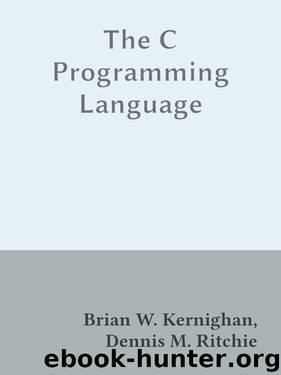The C Programming Language by Brian W. Kernighan Dennis M. Ritchie

Author:Brian W. Kernighan, Dennis M. Ritchie [Brian W. Kernighan, Dennis M. Ritchie]
Language: eng
Format: epub
Tags: c, programming
Published: 2014-08-21T16:00:00+00:00
6.9 Bit-fields
When storage space is at a premium, it may be necessary to pack several objects into a single machine word; one common use is a set of single-bit flags in applications like compiler symbol tables. Externally-imposed data formats, such as interfaces to hardware devices, also often require the ability to get at pieces of a word.
Imagine a fragment of a compiler that manipulates a symbol table. Each identifier in a program has certain information associated with it, for example, whether or not it is a keyword, whether or not it is external and/or static, and so on. The most compact way to encode such information is a set of one-bit flags in a single char or int.
The usual way this is done is to define a set of “masks” corresponding to the relevant bit positions, as in
#define KEYWORD 01 #define EXTRENAL 02 #define STATIC 04
or
enum { KEYWORD = 01, EXTERNAL = 02, STATIC = 04 };
The numbers must be powers of two. Then accessing the bits becomes a matter of “bit-fiddling” with the shifting, masking, and complementing operators that were described in Chapter 2.
Certain idioms appear frequently:
flags |= EXTERNAL | STATIC;
turns on the EXTERNAL and STATIC bits in flags, while
flags &= ~(EXTERNAL | STATIC);
turns them off, and
if ((flags & (EXTERNAL | STATIC)) == 0) ...
is true if both bits are off.
Although these idioms are readily mastered, as an alternative C offers the capability of defining and accessing fields within a word directly rather than by bitwise logical operators. A bit-field, or field for short, is a set of adjacent bits within a single implementation-defined storage unit that we will call a “word.” For example, the symbol table #defines above could be replaced by the definition of three fields:
struct { unsigned int is_keyword : 1; unsigned int is_extern : 1; unsigned int is_static : 1; } flags;
This defines a variable table called flags that contains three 1-bit fields. The number following the colon represents the field width in bits. The fields are declared unsigned int to ensure that they are unsigned quantities.
Individual fields are referenced in the same way as other structure members: flags.is_keyword, flags.is_extern, etc. Fields behave like small integers, and may participate in arithmetic expressions just like other integers. Thus the previous examples may be written more naturally as
flags.is_extern = flags.is_static = 1;
to turn the bits on;
flags.is_extern = flags.is_static = 0;
to turn them off; and
if (flags.is_extern == 0 && flags.is_static == 0) ...
to test them.
Almost everything about fields is implementation-dependent. Whether a field may overlap a word boundary is implementation-defined. Fields need not be named; unnamed fields (a colon and width only) are used for padding. The special width 0 may be used to force alignment at the next word boundary.
Fields are assigned left to right on some machines and right to left on others. This means that although fields are useful for maintaining internally-defined data structures, the question of which end comes first has to be carefully considered when picking apart externally-defined data; programs that depend on such things are not portable.
Download
This site does not store any files on its server. We only index and link to content provided by other sites. Please contact the content providers to delete copyright contents if any and email us, we'll remove relevant links or contents immediately.
| C | C++ |
| Tutorials | Visual C++ |
Hello! Python by Anthony Briggs(9399)
OCA Java SE 8 Programmer I Certification Guide by Mala Gupta(9364)
The Mikado Method by Ola Ellnestam Daniel Brolund(9330)
Algorithms of the Intelligent Web by Haralambos Marmanis;Dmitry Babenko(7873)
Sass and Compass in Action by Wynn Netherland Nathan Weizenbaum Chris Eppstein Brandon Mathis(7419)
Test-Driven iOS Development with Swift 4 by Dominik Hauser(7368)
Grails in Action by Glen Smith Peter Ledbrook(7313)
The Well-Grounded Java Developer by Benjamin J. Evans Martijn Verburg(7140)
Secrets of the JavaScript Ninja by John Resig Bear Bibeault(5978)
Kotlin in Action by Dmitry Jemerov(4662)
Hands-On Full-Stack Web Development with GraphQL and React by Sebastian Grebe(3940)
Functional Programming in JavaScript by Mantyla Dan(3730)
Learning Java by Patrick Niemeyer & Daniel Leuck(2877)
Windows APT Warfare by Sheng-Hao Ma(2868)
Mastering Python for Finance by Weiming James Ma;(2858)
Learning React: Functional Web Development with React and Redux by Banks Alex & Porcello Eve(2850)
WordPress Plugin Development Cookbook by Yannick Lefebvre(2634)
Mastering Java 9 by Dr. Edward Lavieri(2578)
Architecting Modern Java EE Applications: Designing lightweight, business-oriented enterprise applications in the age of cloud, containers, and Java EE 8 by Daschner Sebastian(2566)
